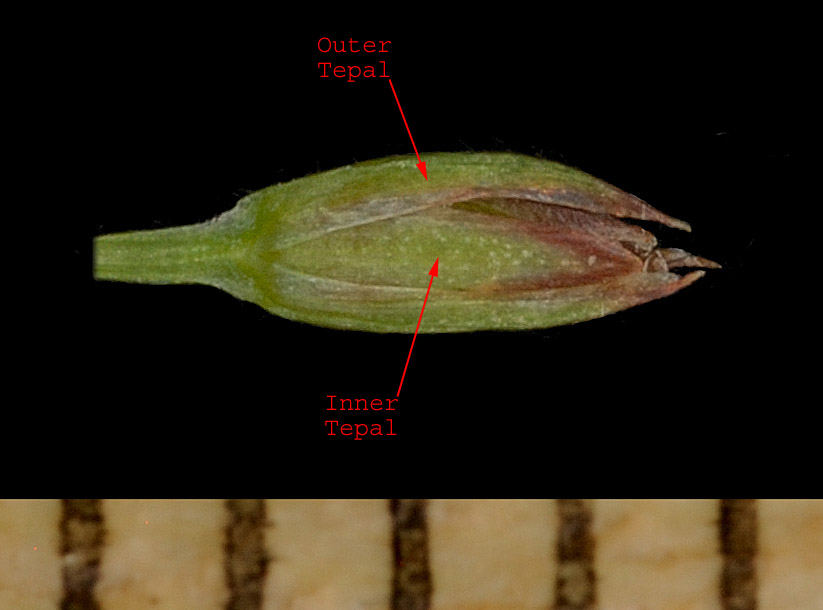 |
Alpinoarticulatus: Answers
to key questions in Rushes, Bulrushes & Pondweeds plus the remaining
Monocots of Saskatchewan by V. L. Harms, A. L. Leighton, and M. A. Vetter
leading to this species. The answers are in the order you would
normally work through the key.
 |
Tepals not
subtended by a pair of bracteoles; flowers borne in tight clusters of 2
-100 (sometimes 1-flowered in Juncus stygius var. americanus), these
clusters (glomerules) subtended by small bracts; leaf blades
septate (in most species) or not. NOT [Tepals subtended by a pair
of floral bracteoles immediately below the flower; flowers borne singly
in the inflorescence either +/- evenly distributed or +/- grouped in
loose clusters (not in tight clusters, and if grouped in clusters
individual flowers and paired floral bracteoles are still visible and
not so tightly crowded such that individual flowers cannot be fairly
easily identified); leaf blades, if present, not septate.] |
 |
Leaf
blades terete or +/-canaliculate or +/- flattened dorsiventrally (not
flattened laterally or equitant), usually < 3 mm wide. NOT
[Leaf blades flattened laterally (folded lengthwise), ensiform and
equitant, 1.5 - 6 mm wide.] |
 |
Primary
bracts not distinctly white-scarious, may be somewhat but not broadly
inflated at base, apices obtuse to acute; tepals with margins narrower,
to one-third width of tepals, indistinct or membranous or scarious;
anthers much shorter to 2 times longer than filaments; styles of various
lengths; capsules variously locular with mucros to 0.5 mm (0.5 - 0.7 mm
in J. castaneus) or gradually tapering into long narrow beaks; leaf
blades terete or subterete (laterally flattened to subterete in J.
nevadensis) or canaliculate (J. castaneus, which is recorded only from
the ne corner of the province), septate or indistinctly septate.
NOT [Primary bracts distinctly white-scarious and conspicuously inflated
at the base, apices narrowly attenuate to caudate; tepals with wide
(>= one-third width of tepals) scarious margins; anthers 2 - 3 times
longer than filaments; styles 0.6 - 0.9 (1.2) mm long; capsules
3-locular with (0.5) 0.6 - 1.0 (1.1) mm long mucros; leaf blades +/-
canaliculate, not septate.] |
 |
Plants
without the following combination of characteristics (but note that the
glomerules may be solitary or few). NOT [Glomerules solitary
(rarely 2), (1) 3 - 4 (5)-flowered; primary bracts about equal to
inflorescences in length; leaves all basal, blades 0.3 - 1 mm wide,
20-80 (100) mm long, with apices blunt, black and callose; anthers ca.
one-quarter filament length; plants 3-25 (35) cm high, recorded from
only 2 locations in northern boreal and subarctic transitional forest
regions.] |
 |
Capsules
shorter, up to 5 mm long (except up to 5.7 mm long in Juncus torreyi),
included or exserted; seeds 0.4 - 1.2 mm long with very short apicula;
leaf blades mostly distinctly septate (septa externally indistinct in
Juncus mertensianus). NOT [Capsules (5) 5.5 - 8.5 (9) mm long,
long-exserted; seeds 2.4 - 3.5 mm long including conspicuous 0.8 - 1.1
(1.6) mm long apicula; leaf blades indistinctly septate; not found south
of the boreal forest.] |
 |
Inflorescences,
if compact glomerules, then glomerules 2 - 15+ (very rarely 1);
glomerules 2 - 100 flowered, variously-shaped; tepals green,
stramineous, chestnut- to dark brown but not dark purplish brown to
black; capsules 1-locular or pseudo-3-locular or imperfectly-3-locular;
leaf blades terete (flattened to subterete in Juncus nevadensis),
septate. NOT [Inflorescences solitary (very rarely a
tightly-congested cluster of 2) terminal glomerules; glomerules 12 - 60
flowered, globose to subglobose; tepals dark purplish brown to black;
capsules 1-locular; leaf blades septate but septa externally
indistinct.] |
 |
Primary
bracts <= the inflorescences; capsules rounded, obtuse or acute with
mucros or short beaks; tepals narrowly lanceolate to oblong with tips
acute-acuminate, sometimes mucronate, rarely obtuse; glomerules (2) 3 -
10 mm long with 2 - 13 flowers; capsules 1-locular or
imperfectly-3-locular. NOT [Primary bracts usually longer to much longer
than the inflorescence; capsules tapered from near base into long narrow
beaks; tepals lanceolate-subulate, acuminate; glomerules 6 - 15 mm long
with 6 - 100 flowers; capsules 1-locular.] |
 |
Capsules
+/- equal to or up to much longer than tepals, imperfectly-3-locular;
primary bracts 10 - 100 mm long, apices blunt; styles 0.1 - 0.3 mm long;
anthers 0.3 - 0.7 mm long, +/- shorter than filaments; leaf blades
terete, septate at regular intervals. NOT [Capsules shorter to +/-
longer than tepals, 1-locular; primary bracts 7 - 15 (40) mm long,
apices acute to acuminate; styles (0.7) 1 - 1.8 mm long; anthers 0.8 - 2
mm long, 1 - 2 times longer than filaments; leaf blades laterally
flattened to subterete, septate.] |
 |
Leaf
blades to 1 mm wide with green to light brown sheaths and membranous
auricles 0.8 - 1 mm long; capsules oblong to ovoid/obovoid, 2.3 - 3.2 mm
long, +/- equal to perianth to slightly exserted, 1.1 - 1.5 mm wide;
sepals 1.8 - 3 mm long, lanceolate-oblong; stamens 6; seeds 0.5 - 0.8 mm
long including 0.05 - 0.1 mm long apicula. NOT [Leaf blades to 2.5
mm wide with reddish yellowish sheaths and scarious auricles 0.5 - 3 mm
long; capsules narrowly ellipsoidal, 3.2 - 4.8 mm long, long-exserted,
1.0 - 1.2 mm wide; sepals 2.3 - 3.2 mm long, narrowly lanceolate;
stamens 3 (6); seeds 0.7 - 1.2 mm long including 0.1 - 0.3 mm long
apicula.]
|
|
 |
Juncus: Answers
to key questions in Rushes, Bulrushes & Pondweeds plus the remaining
Monocots of Saskatchewan by V. L. Harms, A. L. Leighton, and M. A. Vetter
leading to this genus.
 |
Leaves
various, glabrous; sheaths open, often with margins projected as
auricles; flowers with or without a pair of floral bracteoles
immediately below the tepals; capsules 1- or 3-locular (or pseudo- or
incompletely-3-locular), placentation axile or parietal; seeds many.
NOT [Leaves +/- flat and grass-like, sparsely to densely ciliate;
sheaths closed (or sometimes partially splitting later), auricles
absent; flowers with 1 - 2 floral bracteoles immediately below the
tepals; capsules 1-locular, placentation basal; seeds 3.] |
|

